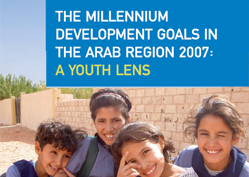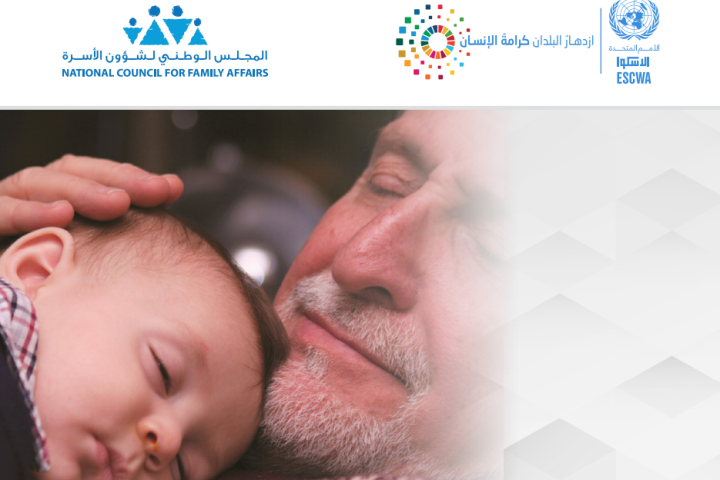A place of many disparities, the Arab region has made important, even if unequal, strives towards reaching the Millennium Development Goals (MDGs), a new report by the United Nations and the League of Arab States says. However, only with serious effort and commitment can the the goals be attained in this part of the world.
The Millennium Development Goals in the Arab Region 2007: A Youth Lens
During the past decade, Arab countries have made significant progress towards achieving the Millennium Development Goals (MDGs), but stronger and more concerted efforts are required to promote development in the Arab Least Developed Countries (LDCs) and in the countries and territories suffering from armed conflict, a new report by the United Nations and the League of Arab States has found.
The report, entitled "Millennium Development Report in the Arab Region 2007: A Youth Lens", was launched during the UN-ESCWA bi-annual Ministerial Session, on 27 May 2008, in Sana’a, Yemen. It is the result of collaborative efforts between United Nations agencies and the League of Arab States, and the second in a series of publications on the MDGs, initiated with the progress report launched in 2005 on the MDGs in the Arab Region.
Adopted in September 2000, the Millennium Declaration set forth 8 time-bound and measurable Goals as well as 18 targets to be achieved by 2015. The Goals are universal, and represent a blueprint of economic, civil, cultural, political and social human rights. As we reach the midpoint for the attainment of these Goals, certain regions in the world still lag behind and are unlikely to meet these targets by their set date.
Growing Pains
The report points out that future progress towards attainment of the MDGs in the Arab region depends to a large extent on the ability of national authorities to address the needs and challenges of young people aged 15 to 24 more adequately. Since 1980, the total number of young men and women living in the Arab world has doubled, and today, this age group accounts for more than 20 per cent of the total Arab population of about 330 million. With such an unprecedented number of young people, Governments in the Arab region should pay particular policy attention to the specific needs and priority issues of this demographic group.
According to the report, there are three priority areas of youth development in the Arab region: education and employment; political, social, and cultural participation, and environmental sustainability and health issues. With around 25 per cent of young people unemployed and a steady increase of the number of new labour market entrants, pressure is mounting on Arab governments to generate decent jobs and income-earning opportunities. This requires addressing both the demand and the supply side of labour markets, by increasing educational standards, tailoring school curricula better to the needs of the labour market, and facilitating moves between the private and the public sector, for example. At the same time, it is crucial to promote active citizenship among young people, to capitalize on the catalytic role of youth as agents of social, political, and economic transformation, and to strengthen health awareness and environmental responsibility among this demographic group. In this regard, the also report presents a youth policy framework for the Arab region, which addresses the existing development constraints both at the micro and the macro level.
Worlds Apart
As highlighted in the report, there are considerable disparities in living conditions and in progress towards the MDGs between Arab subregions and individual countries. Therefore, there is a need for intensified regional and South-South cooperation. Additional global and regional support is specifically needed for people living in conflict-ridden Iraq and Palestine and in the six Arab Least Developed Countries - Comoros, Djibouti, Mauritania, Somalia, Sudan, and Yemen - where extreme poverty is widespread and maternal, child, and infant mortality rates remain very high.
The report also provides the most recent information on Arab countries' progress towards each of the MDGs, documenting the increased efforts invested by Arab governments in meeting the goals. Most Maghreb, Mashreq, and Gulf Cooperation Council (GCC) countries have made significant progress towards achieving the MDGs by 2015, particularly in the areas of health and education. Arab LDCs, especially the Sudan and Yemen, have also achieved substantial improvements in several key areas of development. This is exemplified by higher school enrolment rates, especially among girls, lower prevalence rates of Malaria and Tuberculosis, and a higher proportion of births attended by skilled health personnel. However, there have also been severe setbacks and constraints attributable to a number of factors. Those include the relatively poor economic performance of the region in the 1990s, inadequate financing of social policies, a frequent lack of administrative and managerial competencies, and increasing political tensions and conflicts.
As a result, the Arab region as a whole has not succeeded in reducing income poverty substantially over the past 15 years. While poverty rates in several countries including Egypt, Morocco, and Tunisia have declined significantly, there has been almost no progress in the Arab LDCs, where an estimated 32 million people live below the poverty line. In Iraq and Palestine, poverty has expanded dramatically as a result of conflict and occupation. To combat poverty in the region, the focus will need to be on peace and stability, social inclusion, intraregional cooperation and on policies that create jobs. Policies will need to particularly address rural areas, as rural poverty rates in most Arab countries significantly exceed those for urban areas.
However, most Arab countries achieved significant progress in access to education at all levels despite rapid population growth. Primary school enrolment rates in the Maghreb, Mashreq, and GCC countries are today above 90 percent. Yet, while Arab LDCs have progressed considerably since 1990, an estimated 4.2 million children aged 5-9 living in those countries are still out of school. In addition to ensuring that all children complete a full course of primary education, policies need to focus on improving the quality of education and on tailoring school curricula better to the demands of the labour market.
Investing in the Future
The report stresses that achieving faster progress towards the MDGs in the Arab region does not only require stronger domestic policy efforts, but also more generous and effective financial assistance from developed countries and a further strengthening of regional cooperation between Arab countries. Additional financial support and stronger regional cooperation is required, among other things, to overcome the digital divide that separates the GCC countries from the rest of the region. In countries such as Iraq, Mauritania, and Yemen only a small fraction of the population use personal computers and less than 1 per cent access the Internet. Total official development assistance (ODA) to Arab countries declined by almost 60 per cent during the 1990s, while the distribution of ODA within the region continues to be biased against some of the poorest countries. That is because geopolitical reasons, economic interests and past colonial ties often prevail over developmental needs when decisions concerning aid allocation are made by major donors.
To read or download the full report, please go to:




